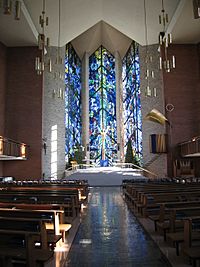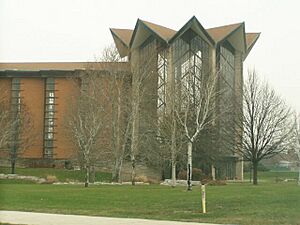Chapel of the Resurrection (Valparaiso, Indiana) facts for kids
Quick facts for kids Chapel of the Resurrection |
|
|---|---|

Nave and chancel, including altar and stained glass, in the Chapel
|
|
| 41°27′47″N 87°02′30″W / 41.463105°N 87.041723°W | |
| Location | Valparaiso, Indiana |
| Country | United States |
| Denomination | Lutheran |
| History | |
| Former name(s) | Memorial Chapel |
| Dedicated | September 27, 1959 |
| Consecrated | September 27, 1959 |
| Architecture | |
| Architect(s) | Charles Stade and Associates |
| Architectural type | Chapel |
| Style | Modern |
| Groundbreaking | October 28, 1956 |
| Completed | 1959 |
| Construction cost | $7.5 million |
| Specifications | |
| Capacity | 2000 |
| Height | 58 feet (18 m) |
| Dome height (outer) | 98 feet (30 m) |
|
Valparaiso University Chapel of the Resurrection
|
|
| NRHP reference No. | 100007172 |
|---|---|
| Added to NRHP | November 16, 2021 |
The Chapel of the Resurrection is a very important building at Valparaiso University in Valparaiso, Indiana. It's like the heart of the campus!
This chapel is mainly used for Lutheran church services for students and staff. But it's also a place for many other events. You might see musical performances, special guest speakers, or even graduation ceremonies here.
The chapel has a tall, round area called the chancel, which is about 98 feet (30 meters) high. Its roof looks like a nine-pointed star. The main seating area, called the nave, is 58 feet (18 meters) high and 193 feet (59 meters) long. The building can hold around 2000 people, depending on how the chairs are set up.
Next to the chapel, there's a tall bell tower called the Brandt Campanile. It has 12 bells and stands 143 feet (44 meters) tall. The Chapel of the Resurrection is built on the highest spot at Valparaiso University. It's easy to see from nearby roads and is a well-known landmark in Northwest Indiana.
Building the Chapel
Work on the Chapel began in 1956. The main design was created by an architecture company called Stade, Dolan, Anderson. However, many special parts of the chapel were designed by other artists. For example, the beautiful stained glass windows and the stone area for baptisms were made by different artists.
Peter Dohmen Studios designed the tall stained glass windows, which are 95 feet (29 meters) high. They also created the marble altar and a mosaic at the chapel's entrance. Adalbert Raphael Kretzmann, who was a pastor and the brother of the university's president, helped design the building too.
Special Art and Features
The altar inside the chapel is 20 feet (6.1 meters) long and made from different kinds of Italian marble. Peter Dohmen designed special inlaid marble stands on the altar. These stands show symbols for the four evangelists, who wrote parts of the Bible.
- Matthew is shown as an angel.
- Mark is shown as a lion.
- John is shown as an eagle.
- Luke is shown as an ox.
Peter Dohmen was a very talented artist who studied in Europe. He became famous in Germany in the 1930s for his stained glass, frescos, and mosaics. He moved to the United States in 1951 and continued his art. He also designed stained glass windows for the library at the University of Notre Dame.
The chapel cost about $7.5 million to build. Much of this money came from people who donated to the university. The building was officially opened in 1959 as part of Valparaiso University's 100th birthday celebration. It was named the Chapel of the Resurrection in 1969.
In 2005, a special walking path called a prayer labyrinth was built on the east side of the chapel. It is 64 feet (20 meters) wide. In 2014, the university added a new section to the building, called the Helge Center, which is 11,000 square feet (1,000 square meters).
The Chapel Organ
The large organ in the chapel is called the Reddel Organ. It was built by Herman Schlicker in Buffalo, New York. The agreement to build the organ was signed on September 27, 1957. It cost $68,000 at that time.
The organ was officially used for the first time during a church service on September 27, 1959. That evening, a famous organ player named E. Power Biggs gave a concert. More than 2,000 people came to listen, which was a record for the chapel! The organ was updated and made larger in 1995–1996 by Dobson Pipe Organ Builders.
Similar Buildings
- Coventry Cathedral: This church in Coventry, England, has a very similar modern style.
- Christ Church Lutheran (Minneapolis, Minnesota): This church influenced the design of the Chapel of the Resurrection. Its pastor later became the Dean of the Chapel at Valparaiso University.
- First Unitarian Society of Madison Meeting House: This church was designed by the famous architect Frank Lloyd Wright and also influenced the chapel's design.


